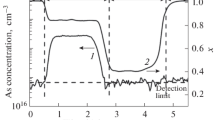Abstract
Iodine doping of CdTe layers grown on (100) GaAs by metal-organic vapor phase epitaxy (MOVPE) was studied using diethyltelluride (DETe) and diisopropyltelluride (DiPTe) as tellurium precursors and ethyliodine (EI) as a dopant. Electron densities of doped layers increased gradually with decreasing the growth temperature from 425°C to 325°C. Doped layers grown with DETe had higher electron densities than those grown with DiPTe. When the hot-wall temperature was increased from 200°C to 250°C at the growth temperature of 325°C, doped layers grown with DETe showed an increase of the electron density from 3.7×1016 cm−3 to 2.6×1018 cm−3. On the other hand, such an increase of the electron density was not observed for layers grown with DiPTe. The mechanisms for different doping properties for DETe and DiPTe were studied on the basis of the growth characteristics for these precursors. Higher thermal stability of DETe than that of DiPTe was considered to cause the difference of doping properties. With increasing the hot-wall temperature from 200°C to 250°C, the effective ratio of Cd to Te species on the growth surface became larger for layers grown with DETe than those grown with DiPTe. This was considered to decrease the compensation of doped iodine and to increase the electron density of layers grown with DETe. The effective ratio of Cd to Te species on the growth surface also increased with decreasing growth temperature. This was considered to increase the electron density with decreasing growth temperature.
Similar content being viewed by others
References
B.C. Easton, C.D. Maxey, P.A.C. Whiffin, J.A. Roberts, I.G. Gale, and F. Grainger, J. Vac. Sci. Technol. B9, 1682 (1991).
D. Rajavel and C.J. Summers, Appl. Phys. Lett. 60, 2231 (1992).
R.G. Benz II, A. Conte-Matos, B.K. Wagner, and C.J. Summers, Appl. Phys. Lett. 65, 2836 (1994).
S. Murakami, T. Okamoto, K. Maruyama, and H. Takigawa, Appl. Phys. Lett. 63, 899 (1993).
P. Mitra, T.R. Schimert, F.C. Case, S.L. Barnes, M.B. Reine, R. Starr, M.H. Weiler, and M. Kestigian, J. Electron. Mater. 24, 1077 (1995).
E.D. Jones and J.C. Clark, Narrow Gap Cadmium-Based Compounds, ed. P. Capper (London: Inspec and IEE, 1994), pp. 472–486.
G.B. Stringfellow, Organometallic Vapor-Phase Epitaxy (Boston: Academic Press, 1989), pp. 43–47 and 168–169.
S. Seto, A. Tanaka, Y. Masa, and K. Kawashima, J. Cryst. Growth 117, 271 (1992).
Y. Marfaing, Thin Solid Film, 387, 123 (2001).
D. Brun-Le-Cunff, T. Baron, B. Daudin, S. Tatarenko, and B. Blanchard, Appl. Phys. Lett. 67, 965 (1995).
Author information
Authors and Affiliations
Rights and permissions
About this article
Cite this article
Yasuda, K., Tomita, Y., Masuda, Y. et al. Growth condition of iodine-doped n+-CdTe layers in metal-organic vapor phase epitaxy. J. Electron. Mater. 31, 785–790 (2002). https://doi.org/10.1007/s11664-002-0236-y
Received:
Accepted:
Issue Date:
DOI: https://doi.org/10.1007/s11664-002-0236-y



